This page serves as the portal for a series of 6 papers in relation to the gravitational wave (GW) event. The LIGO-VIRGO Collaboration (LVC) issued a trigger known as GW170817, a candidate binary neutron star event discovered on Aug. 17, 2017. DES-GW followed this up based on the sky localization provided by LVC and was one of a few groups that rapidly and independently identified an associated optical transient in the galaxy NGC 4993. Over the following nights, this object was repeatedly observed for the DES-GW program with DECam and the fading light curve measured.
Link to all papers on the Astrophysical Journal Letters.
All papers will also be listed on the DES Publications page.
All media coverage and press releases can be found on the DES in the News page.
The dataset used is available for those who wish to write their own follow up papers.
Data access:
Lightcurve Data: lightcurve_mrt_v4.txt
Kilonova data: kn_data_v2.tar
Use of these datasets should include citations to the Cowperthwaite et al. and Soares-Santos et al. papers.
From the simulation paper Scolnic et al. (https://arxiv.org/abs/1710.05845)
SED time series that has been warped to match the photometry. It is important to note that these SEDs are not spectral data, nor are they spectral models. They are empirically warped so that synthetic photometry matches the photometric data.
If this page formats strangely, please try setting your zoom to 100%.
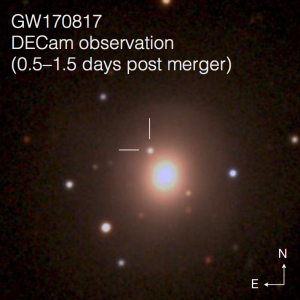
NGC4993 grz color composites (1.5’×1.5’). Composite of detection images, including the discovery z image taken on 2017 August 18 00:05:23 UT and the g and r images taken 1 day later; the optical counterpart of GW170817 is at RA,Dec = 197.450374, −23.381495.
THE ELECTROMAGNETIC COUNTERPART OF THE BINARY NEUTRON STAR MERGER LIGO/VIRGO GW170817.
I. DISCOVERY OF THE OPTICAL COUNTERPART USING THE DARK ENERGY CAMERA
Soares-Santos et al.
Contact: marcelle@fnal.gov | Paper | arXiv link
This is the first paper of the series describing results of our followup observations of GW170817 using DECam. We present observations that led to our independent discovery of the optical source and we establish its association with GW170817 by showing that none of the 1500 other sources found within the event localization region could plausibly be associated with the event. We monitored the source for over two weeks and provide the lightcurve data as a machine-readable file in this link. Detailed modeling of the source is performed in a companion paper (Cowperthwaite et al. 2017). A measurement of the Hubble constant, the first utilizing a gravitational wave event as a standard siren measurement of distance, is enabled by this work (LVC, et al. 2017). A study of the event’s host galaxy (Palmese et al. 2017) and of the probability of detecting more of these sources in past and future surveys (Scolnic et al. 2017) also resulted from this program which is featured in an overview paper of all followup programs (LVC, et al. 2017)
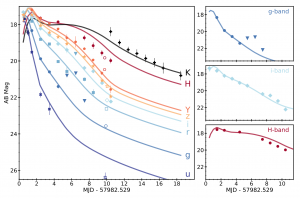
UV, optical, and NIR Light curves of the counterpart of GW170817. The two-component model for r-process heating and opacities (Section 4) is shown as solid lines. Triangles represent 3σ upper limits. Error bars are given at the 1σ level.
THE ELECTROMAGNETIC COUNTERPART OF THE BINARY NEUTRON STAR MERGER LIGO/VIRGO GW170817.
II. UV, OPTICAL, AND NEAR-IR LIGHT CURVES AND COMPARISON TO KILONOVA MODELS
Cowperthwaite et al.
Contact: pcowpert@cfa.harvard.edu | Link | arXiv link
This paper presents photometry of the optical/NIR counterpart to GW170817 using data from DECam, the Hubble Space Telescope, and Gemini-South. We model these data finding that they are consistent with the emission expected for an r-process powered kilonova. The inferred ejecta mass is consistent with the suggestion that neutron star mergers are a dominant site of r-process production in the Universe.
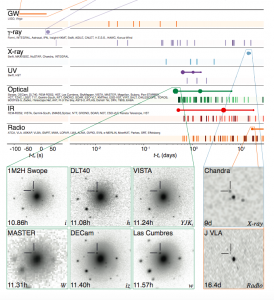
Timeline of the discovery of the gravitational-wave event, gamma-ray burst, and electromagnetic transient and the multi-wavelength follow-up relative to the time of the gravitational-wave event, including the DES/DECam follow-up.
THE MULTI-MESSENGER DISCOVERY AND OBSERVATION OF A BINARY NEUTRON STAR MERGER
Abbott et al.
Contact: eberger@cfa.harvard.edu | Link | arXiv link
This paper announces the first multi-messenger observations of a binary neutron star merger, which was detected in gravitational waves, as a short gamma-ray burst, and as an electromagnetic transient. The optical observations identified the source as in the galaxy NGC 4993, which LIGO/Virgo determined is at a distance of 40 Mpc from the gravitational-wave signal. The multi-band light curves and spectra are consistent with a kilonova explosion produced by the neutron star merger.
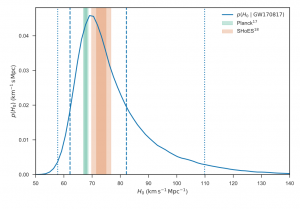
GW170817 measurement of H0. Marginal- ized posterior density for H0 (blue curve). Constraints at 1- and 2σ from Planck (Planck Collaboration et al. 2016) and SHoES (Riess et al. 2016) are shown in green and orange. The maximum a posteriori value and minimal 68.3% credible interval from this PDF is H0 = 70.0+12.0 km s 1 Mpc 1. The 68.3% (1σ) and 8.0 95.4% (2σ) minimal credible intervals are indicated by dashed and dotted lines.
A GRAVITATIONAL-WAVE STANDARD SIREN MEASUREMENT OF THE HUBBLE CONSTANT
Abbott et al.
Contact: annis@fnal.gov | Paper | arXiv link
This paper presents the first standard siren measurement of the Hubble constant. The gravitational wave measurement of GW170817 provides a direct estimate of the distance to the source, without the use any sort of distance ladder. Instead, the distance is calibrated by the theory of general relativity. The identification of the host galaxy, NGC 4993, allows a completely independent measurement of the redshift of the source. By combining these two quantities, we determine a value for the Hubble constant. This value, while consistent with existing measurements, is a completely novel and independent way to measure this crucially important cosmological quantity.
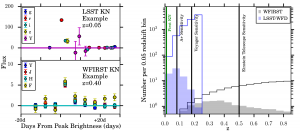
(Left) Example simulated KN light-curves from LSST and WFIRST that pass our selection requirements. The vertical axis flux unit is defined such that mag = 27.5 − 2.5 log(F lux). (Right) KN redshift distributions for all events in the survey footprint (solid histogram) and for events passing selection requirements (shaded histogram). Green vertical line shows the KN redshift (z = 0.0098), and black vertical lines show the sensitivity of future GW experiments.
HOW MANY KILONOVAE CAN BE FOUND IN PAST, PRESENT, AND FUTURE SURVEY DATASETS?
Scolnic et al.
Contact: dscolnic@kicp.uchicago.edu | Link | arXiv link
In this paper, we attempt to answer the question “How many kilonovae (KNe) can be found in past, present and future datasets?” We use the DES-GW light-curve and an estimate of the rate, and detailed simulations of 11 different surveys, to predict KN discovery numbers for each survey. While we find that it is not highly likely more than a couple KNe can be found in past datasets, we predict that tens of KNe can be found in future datasets, and some of these KNe may be even at higher redshift than the sensitivity of future GW experiments.
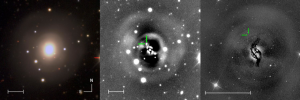
Left panel: DECam coadded image of NCG4993 in gri. Shell structures indicative of a recent galaxy merger are clearly visible. Middle panel: r-band residuals from GALFIT after subtraction of the best-fit single Sérsic light profile. Right panel: F606W-band HST ACS image with a 3 component galaxy model subtracted. Dust lanes crossing the centre of the galaxy are evident after this subtraction. The green lines show the position of the transient. The white bar in each panel shows the 5 kpc scale.
DECAM AND DARK ENERGY SURVEY PERSPECTIVE OF THE GW170817 HOST, NGC 4993: INDICATION FOR DYNAMICALLY–DRIVEN BINARY NEUTRON STAR FORMATION IN EARLY TYPE GALAXIES
Palmese et al.
Contact: antonella.palmese.13@ucl.ac.uk | Link | arXiv link
This paper studies the properties of the gravitational wave host galaxy. Based on the star formation history and the morphology of this galaxy, the authors suggest that the formation of the neutron star binary that produced the gravitational wave signal is related to the dynamical interactions caused by a recent galaxy merger.